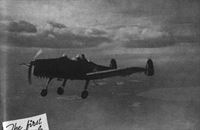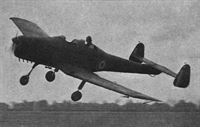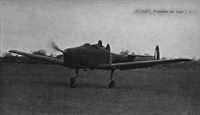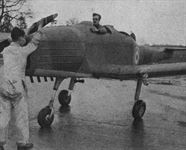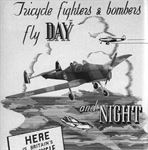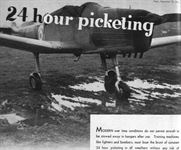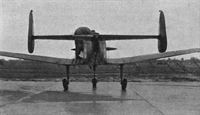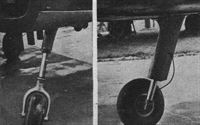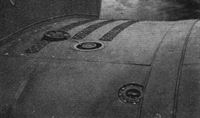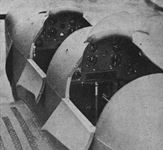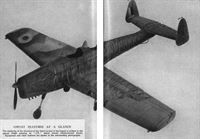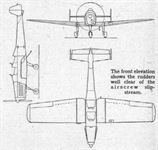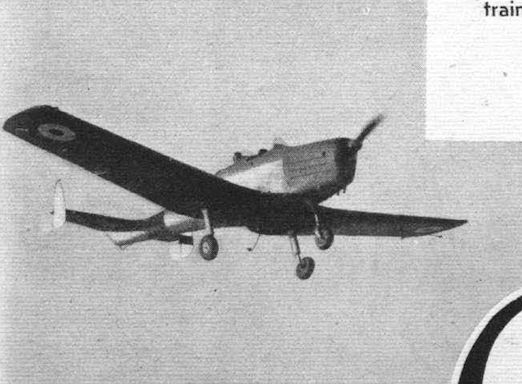
Варианты
- C.W. Aircraft - Cygnet - 1937 - Великобритания
- General Aircraft - Cygnet II / GAL.42 - 1939 - Великобритания
- General Aircraft - Owlet / GAL.45 - 1940 - Великобритания
Flight, November 1940
A TRICYCLE TRAINER
All-metal "Owlet" Equipped for Night Flying and Blind Flying : Many Features of Successful "Cygnet" Retained
ONE of the surprising features of the war is, not that British aircraft export should have dwindled, but that it should exist at all. In spite of all the difficulties arising out of priority claims of materials for military aircraft, of obtaining export licences, and last but not least of finding the time and the men, General Aircraft, Ltd., has persistently pursued the policy that export must, come what may, be kept alive if the country is to remain in a healthy financial condition.
The Cygnet side-by-side two-seater cabin monoplane the manufacture of which the company took over in 1938, has never gone out of production, and recently a Cygnet was sent to South America, where it has created a very favourable impression, not only as an ultra-modern all-metal two-seater, but because it represents a phase of British activity which the friends of Great Britain in Latin America had thought dead for the duration of the war.
Not content with having one type of light aircraft available for export, General Aircraft has, under the energetic directorship of Mr. E. C. Gordon England, designed and built quite recently another two-seater which is suitable not only for export but for work at home. The machine is an all-metal, open-cockpit trainer intended for school work and for specialised training in night flying and blind flying, not to mention training for the large military aeroplanes with tricycle undercarriage which this country has ordered in the United States.
In view of the success of the Cygnet, and because much money has been spent on tooling for its manufacture in numbers, it is not surprising to find that the Owlet, as the new trainer is called, makes use of many of the structural units of the Cygnet, such as wing panels, fuselage portions and so forth. Rather surprisingly, the considerable difference in width of the two fuselages (the Owlet has tandem seating and the Cygnet side-by-side) has not precluded the application of such standardisation on quite a large scale. Many advantages accrue therefrom, including a reduction of cost and a speeding-up of manufacture.
Instant Response
Features which have been found satisfactory in the Cygnet have been retained in the Owlet, and others, desirable in an aircraft intended primarily for training, but not necessarily in one designed to appeal to the private owner, have been added. For example, sensitive controls, giving instant response without jerkiness, are among the particularly noteworthy characteristics of the Owlet; this is agreed by all pilots who have flown the machine. On the occasion of a recent visit by members of Flight's staff, the wind was gusting up to 60 m.p.h. or more, and Mr. Charles Hughesdon not only had no difficulty in giving a series of demonstration flights, but gave us a show of aerobatics the "finished" nature of which was scarcely marred by the gusty wind. Needless to say, the take-offs and landings were greatly facilitated by the tricycle undercarriage, the way in which the machine "stayed put" once the wheels had touched being little short of a revelation. It is safe to say that an aeroplane of comparable wing loading and with orthodox undercarriage would have needed a man on each wing tip, if it had been able to go out at all. The Owlet took no notice of the gusts, there was no sign of "ballooning," and the comparatively wide wheel track made cross-wind taxying at high speeds quite practicable, in spite of the fairly pronounced dihedral angle of the wings.
At first the rather "stilty" undercarriage and the twin rudders strike an unusual note, but one soon becomes accustomed to them, and even if that were not the case, a demonstration such as that which we witnessed would very readily convince one of the logic of the design. Perhaps the whole situation may be summed up by saying that although, at first sight, the Owlet does not look pretty, it does look right. And actual experience of several pilots seems to prove that this impression is borne out in practice.
General Aircraft should do well with the Owlet if the authorities take a sensible view and remove such obstacles as stand in the way of obtaining materials. The machine is obviously well suited to ab initio training, as the time which a pupil normally spends in learning the art of taking off and landing should be very materially reduced, thanks to the three-wheeled undercarriage. Furthermore, it is known that Great Britain has ordered from the United States of America numbers of military aircraft, large and small, bombers and fighters, which have tricycle undercarriages. Conversion courses will have to be given to pilots who have not previously flown aeroplanes so equipped, and the Owlet would seem to be very suitable for the purpose. And it would be good logic and sound sense to look ahead, as Mr. Churchill does, to a long war and to the time when pupils who will be starting training soon will be called upon to fly military three-wheelers. If they start their training on tricycles they will take the more readily to the high-power types which they will ultimately fly.
For "ab initio" Training
It is to be hoped that the Owlet will be carefully considered in connection with the Empire Training Scheme. Obviously arrangements have gone too far to make drastic changes possible, but it would be worth while to order a number for use as "first step" machines. In other words, instead of spending a lot of time on teaching a pupil to make landings, before sending him solo, make the learning of landings easy and get him into the air. Afterwards, when the period of clammy hands is behind him, teach him the two-wheel landing technique last instead of first. In that way the Owlet could be made a valuable addition to, but not a substitute for, the orthodox training types in use at present. On their own initiative General Aircraft are sending an Owlet to India, but that principle ought to be extended - with Government encouragement.
Designed as it is both for ab initio flying training and for night flying and blind flying, the Owlet carries a very complete set of instruments and equipment. At the moment the prototype is not fitted with a hood for the pupil, but one is being designed and will complete the usual array of gear. Navigation lights are fitted to wing tips and fuselage stern, and there is a landing light in the leading edge of the centre section, on the port side. On the starboard side is an electric generator driven by a small windmill, so that the electric supply is ensured even in the event of engine failure. A venturi tube for the gyro turn indicator is mounted under the belly of the fuselage, in the path of the warm exhaust gases, where icing is unlikely to occur.
The control surfaces are similar to those of the Cygnet, and the whole tail unit is, in fact, identical and interchangeable with that of the earlier machine. Twin fins and rudders set at the tips of the tailplane reduce the tendency to swing during take-off, and at the same time they act as baffles, thereby increasing the effectiveness of the tail and elevator. Ailerons are of normal type, and trimming tabs are provided, being of the thin sheet metal fixed type which is initially adjusted by simple bending and then left alone. The tab on the elevator is under the control of the pilot, the tailplane incidence being fixed. Mass balances are fitted to all control surfaces.
Air brakes show up to special advantage in three-wheeled aircraft, as they can be used without fear of causing the machine to leave the ground again. Those of the Owlet are vacuum operated, the control lever being mounted on the same quadrant as that which carries the throttle, so that the movement of the pilot's left hand from flap control to throttle control is the shortest possible. The flap position is shown by an indicator on the port side. The landing light is dipped by a lever just above the throttle. The engine switches, by the way, are placed on the outside of the cockpit coaming, where their position can be seen by the ground crew without having to climb on to the wing.
Normal Controls
The flying controls are of orthodox type, the rudder pedals being cranked to give parallel motion. The front wheel is steerable, and is operated by the rudder pedals.
Long travel (approximately 8in.) is provided for the front wheel as well as for the two main wheels. The undercarriage legs are of General Aircraft design and oleo-pneumatic type. They carry Dunlop doughnut wheels fitted with Bendix brakes. The brakes are operated by a handle on the floor, to the left of the seats. The pilot has an overriding control to enable him to release the brakes, should the pupil put them on too hard.
The engine fitted as standard is the Cirrus Major, of 150 b.h.p. It drives a Fairey metal airscrew of 7ft. diameter. A refinement in the fuel system is a streamline sump under the belly of the fuselage. The two tanks in the wing roots (total capacity 26 gallons) feed by gravity to this sump, whence the petrol is forced to the carburettor by an engine-driven pump. This system has been incorporated in order to avoid the formation of air locks. An interesting refinement is a long vent pipe from the oil tank. This runs right to the stern of the fuselage and discharges there.
Seats of the standard service bucket type are used, and their position is adjusted by a simple arrangement of tubular runners.
Structurally, the Owlet is, as already mentioned, similar to the Cygnet in most of its main components. The wing is of the two-spar type, with I-section spars built up of a flat sheet web and extruded flanges in R.R.56 alloy riveted to the web. The web is stiffened by drawn sections riveted to one side of the web. The ribs are of simple sheet type, with top and bottom flanges turned over and angle pieces riveted on. The covering is, of course, sheet metal.
The fuselage has a centre portion of open box section, with longerons at the corners. The top coaming is of wood, and can be removed to facilitate inspection of the interior. The tail portion of the fuselage is identical with that of the Cygnet, but is one bay shorter.
Performance, as such, is of no great importance in a trainer, but it may be of interest to point out that the maximum speed of the Owlet at sea-level and 2,450 r.p.m. is 125 m.p.h. The cruising speed at 2,200 r.p.m. is 110 m.p.h. The sea-level rate of climb is quite good for a trainer, being 770 ft./min., and the service ceiling is 15,000ft.
Of very special interest in a trainer aircraft are the take-off and landing runs. The Owlet, with its effective split flaps and its three-wheeled undercarriage, takes off, in a wind of 5 m.p.h. and a temperature of 5 deg. C, in 210 yards. This is with flaps half-way down. The distance to clear the 50-ft. screen is 475 yards.
Landing run with wheel brakes "on" and the flaps fully down is only 150 yards. On the day when Mr. Hughesdon demonstrated the machine to us the wind was high, the approach angle was very steep, and the landing run was almost nil. Incidentally, the stalling speed with flaps down is 53 m.p.h. The actual landing or touching-down speed may be as low as 60 rn.p.h., but the machine may be put down at speeds up to 80 m.p.h. The undercarriage is designed to stand the loads.
The Owlet is stressed for aerobatics at a loaded weight of 2,000 lb. In the normal category this weight goes up to 2,300 lb.
As weight figures vary according to whether the machine is used as a day trainer or as a night-flying trainer, they are best set out in tabular form.
Day Trainer (lb.) Night Trainer (lb.)
Tare weight (including standard equipment) 1,563 1,644
Crew 340 340
Petrol (26 gals.) 200 200
Oil (3 gals.) 27 27
Parachutes 40 40
Allowance for special equipment and luggage 130 49
All-up weight 2,300 2,300
- Flight, November 1940
A TRICYCLE TRAINER
Фотографии
-
Flight 1940-12 / Flight Advertisements
Регистрационный номер: G-AGBK [27] -
Flight 1940-11 / Flight
Регистрационный номер: G-AGBK [27] -
Flight 1940-11 / Flight Advertisements
Регистрационный номер: G-AGBK [27] -
Flight 1940-11 / Flight
Регистрационный номер: G-AGBK [27] In spite of a blustery wind, Mr. Hughesdon was able, thanks to the very effective controls, to do a banked turn close to the ground.
-
Flight 1940-12 / Flight
Регистрационный номер: G-AGBK [27] The Owlet (Cirrus Major) is an ab initio and night-flying trainer with tricycle undercarriage.
-
Flight 1940-11 / Flight
Регистрационный номер: G-AGBK [27] Mr. Charles Hughesdon landing the Owlet in a very high wind. Note how all three wheels are "glued to the ground."
-
Flight 1940-11 / Flight
Регистрационный номер: G-AGBK [27] Getting ready for a flight. Note the long travel of all three oleo-pneumatic legs.
-
Flight 1940-12 / Flight Advertisements
Регистрационный номер: G-AGBK [27] -
Flight 1940-11 / Flight Advertisements
Регистрационный номер: G-AGBK [27] -
Flight 1940-12 / Flight Advertisements
Регистрационный номер: G-AGBK [27] MODERN war time conditions do not permit aircraft to be stowed away in hangars after use. Training machines, like fighters and bombers, must bear the brunt of constant 24 hour picketing in all weathers without any risk of deterioration of the airframe or engine.
-
Flight 1940-11 / Flight
Регистрационный номер: G-AGBK [27] In spite of the large dihedral angle of the wings, the Owlet is very stable in a cross wind.
-
Flight 1940-11 / Flight
Регистрационный номер: G-AGBK [27] Tailpiece. The fins and rudders increase the effectiveness of the elevator.
-
Flight 1940-11 / Flight
Регистрационный номер: G-AGBK [27] The tail of the Owlet is identical with that of the Cygnet, and is interchangeable with it.
-
Flight 1940-11 / Flight
Регистрационный номер: G-AGBK [27] The Cirrus Major engine installation is very accessible when the engine cowling is removed. For inspection the cowling is merely hinged upwards.
-
Flight 1940-11 / Flight
Регистрационный номер: G-AGBK [27] The front undercarriage leg and fork and starboard main undercarriage leg showing the brake-operating cable.
-
Flight 1940-11 / Flight
Регистрационный номер: G-AGBK [27] The fuel and oil filler orifices. Note the streamlined rubber cover.
-
Flight 1940-11 / Flight
Регистрационный номер: G-AGBK [27] The split trailing edge flaps are of all-metal construction.
-
Flight 1940-11 / Flight
Регистрационный номер: G-AGBK [27] The position of the flap is shown by the indicator.
-
Flight 1940-11 / Flight
Регистрационный номер: G-AGBK [27] The views (7 and 8) show the tail skid and the cantilever step and non-slip walkway.
-
Flight 1940-11 / Flight
Регистрационный номер: G-AGBK [27] The two views (reading to the left) are (7) the fuel sump, under the wing, and (8) one of the rudder cranks. The sump is fed from both tanks and supplies the engine by means of a power-driven pump.
-
Flight 1940-11 / Flight
Регистрационный номер: G-AGBK [27] Reading from top to bottom these are the wind-driven generator (1); the mass balance for the aileron and the pitot head appear next (2), while immediately below this view is seen the mass balance and hinge point for the rudder (3).
-
Flight 1940-11 / Flight
Регистрационный номер: G-AGBK [27] The next three illustrations show the navigation lights, the port light (4), the rear light, situated in the pointed stern between the tail trimming tabs (5), and the landing light, which is located in the port wing (6).
-
Flight 1940-11 / Flight
Регистрационный номер: G-AGBK [27] Fishplate joint of rear to main fuselage portion
-
Flight 1940-11 / Flight
Регистрационный номер: G-AGBK [27] The cockpits, showing some of the numerous instruments. Note that the main engine switches are placed on the outside.
-
Flight 1940-11 / Flight
Регистрационный номер: G-AGBK [27] Details of the controls and other fittings which indicate careful planning. Reading from top to bottom we see (1) the front cockpit controls. The upper lever operates the landing light and the three lower levers operate the throttle, altitude control and flaps respectively. (2) Fuel cock in the front cockpit. Note the De Havilland telephone tubes and Petroflex piping. (3) Control countershaft arranged at the rear of the aft cockpit.
-
Flight 1940-11 / Flight
Регистрационный номер: G-AGBK [27] Details of the controls and other fittings which indicate careful planning. Reading from top to bottom we see (4) The fire extinguisher, which is located in the front cockpit, can be operated by the foot of the rear occupant. Under side of the pilot's seat (5) showing the recesses for the four ball joints, seen in (6), by which the leg length is adjusted.
-
Aeroplane Monthly 1990-09
Регистрационный номер: G-AGBK [27] 50th anniversary of the first flight of the General Aircraft Owlet trainer: September 5, 1940
-
Flight 1940-11 / Flight
OWLET FEATURES AT A GLANCE. The similarity of the structure of the Owlet to that of the Cygnet is evident in this special Flight drawing by "J.P.," which reveals constructional details.
-
Flight 1940-11 / Flight
The front elevation shows the rudders well clear of the airscrew slipstream.
- Фотографии


